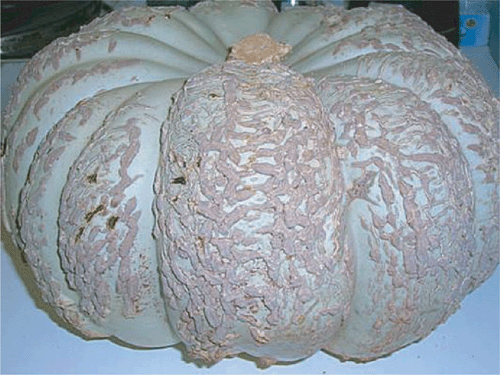Severe oedema on pumpkin fruit in Katherine, NT, Australia
M. S. A. Khan A C and B. D. Condé BA Plant Pathology, Diagnostic Services Division, Department of Primary Industry, Fisheries and Mines, PO Box 1346, Katherine, NT 0851, Australia.
B Plant Pathology, Diagnostic Services Division, Department of Primary Industry, Fisheries and Mines, Berrimah Farm, PO Box 3000, Darwin, NT 0801, Australia.
C Corresponding author. Email: shahid.khan@nt.gov.au
Australasian Plant Disease Notes 3(1) 50-50 https://doi.org/10.1071/DN08020
Submitted: 7 February 2008 Accepted: 6 April 2008 Published: 11 April 2008
Abstract
Oedema of pumpkin fruit, Cucurbita maxima cv. Queensland Blue, is reported from Katherine, Northern Territory, Australia. Symptoms were numerous raised, corky, often linear blisters over most of the fruit surface.
Severe oedema occurred on a crop of pumpkin fruit cv. Queensland Blue (Cucurbita maxima) in Katherine, NT, Australia in September 2007 (Fig. 1). The Queensland Blue cultivar is usually sold commercially in Australia under the ‘Jarrahdale’ label. Symptoms were numerous raised, often linear blisters, occurring on all the above ground surface of the fruit. Severely affected fruit could not be sold on the fresh market, but had to be sold for a reduced price as processed pumpkin (for soup). Blister tissues were cut into 2–3 mm2 pieces, surface sterilised with domestic bleach solution (0.1% available chlorine) for 1–2 min and washed with sterile distilled water (SDW). The blister pieces were plated on one-quarter strength potato dextrose agar (1/4 PDA; Oxoid) and incubated for 7 days at room temperature (~23°C) under alternating 12 h near-UV light (Philips TLD 18w/08) and 12 h darkness. No disease organisms were isolated in culture from fresh blisters. However, fruit tissue in the proximity of affected blisters was subject to earlier physiological breakdown and subsequently secondary rots. Oedema is a physiological condition of plants caused by the accumulation of water in plant tissues. It occurs when roots absorb water quicker than the plant can use it. This can happen when plants are diseased or otherwise stressed so that water utilisation is reduced. The pressure causes epidermal rupture. It is most commonly seen in leaves rather than fruit, e.g. in mangoes in the Northern Territory (Chin et al. 2002). The conditions leading to this present case of oedema in pumpkin fruit were a sudden lowering of night temperatures (from 18°C to 8–9°C) combined with excessive watering. Watermelon T-tape irrigation was used which delivered much more water than the normal pumpkin T-tape irrigation. This oedema of pumpkin fruit was seen on this farm only and only on this fruit cultivar because the condition for oedema (stress due to a sudden drop in temperature combined with excessive water) coincided with the growing of this variety. This is the first report of oedema of pumpkin fruit (C. maxima) from the Northern Territory of Australia. Oedema of pumpkin fruit was previously reported for the species C. pepo in North Carolina, USA (Stanghellini et al. 2003) and in Ontario, Canada (Anon. 2000).

|
Stanghellini MS,
Schultheis JR, Holmes GJ
(2003) Adaptation and market potential of Jack o’lantern and miniature pumpkin cultivars in Eastern North Carolina. HortTechnology 13, 532–539.



